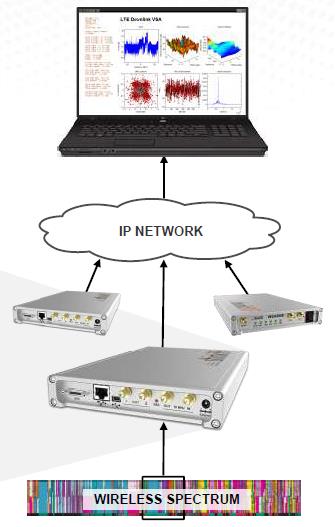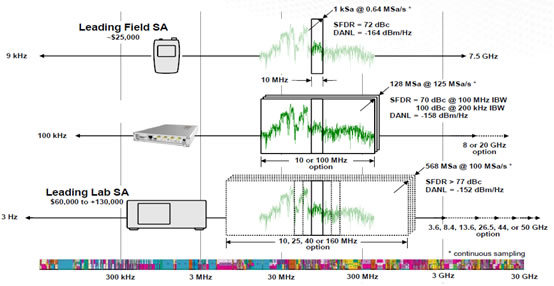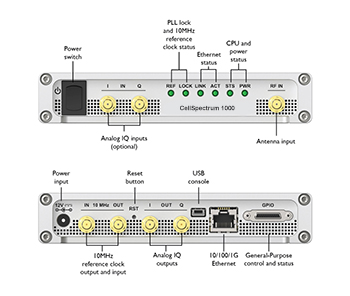CellSpectrum™
Radio Frequency Spectrum and Channel Analysis Platform
 Wireless networks will have to increase capacity tenfold in the next few years and to do this they need to support the new 4G technologies, MIMO and small cells. Wireless networks will have to increase capacity tenfold in the next few years and to do this they need to support the new 4G technologies, MIMO and small cells.
The spectrum used for 4G deployments has to be clean of interference to maximize network throughput, and this is not an easy task to perform.
Deploying OFDM systems, like LTE, requires a precise knowledge of multi-path spread in all network locations.
The new 4G Base Stations use proprietary algorithms to allocate user data and have to communicate with their counterparts to avoid conflicts. This allocation cannot be seen by the operator and it can be a major cause of interference. The use of SON and ICIC technologies will remove from the user the understanding of network issues, as the algorithms used and the decisions made will be hidden from the user.
MIMO antennas can provide a throughput gain or a loss depending on the environment in which they are deployed and their relative positioning. This requires knowledge of the channel frequency response and its time variance.
Small cells working in heterogeneous environments will need a perfect understanding of the RF channel behavior.
All the above topics require knowledge of the RF channel at each network location. Existing tools do not provide such information, which should be collected over the entire network.
CellSpectrum™, a unique, patent-pending, RF Spectrum Scanner and Channel Analyzer based on a universal software-defined receiver (SDRx) that enables the capturing, digitizing, storage and analysis of detailed wideband RF spectrum, has addressed all these issues, capturing data on a wide area during network drives, using either a spectrum analyzer and/or a spectrum digitizer.
- It allows the analysis of important RF channel characteristics needed for the proper design of 4G networks
- It captures the signal of a spectrum analyzer during a network drive and stores the information digitally, so it can be processed in the office
- It captures all LTE channels detectable at each location
- It captures all the multi-path of a specific channel at each location, allowing for a perfect dimensioning of the Cyclic Prefix It displays the channel frequency and time response on a frame basis
- It displays the traffic allocation of all Resource Element in a frame for each antenna port. This allows the analysis own and competitor’s traffic load
- It displays the antenna correlation, essential for MIMO analysis. This allows for the definition of how many antennas should be deployed in each site and what is the best positioning of such antennas.
CellSpectrum digitizes up to 100 MHz of spectrum at a time, from 100 MHz to 18 GHz, extracting parameters as: LTE channel response per Resource Element, Multi-path delay spread, Average frequency fading, Average time fading, Noise floor & interference, Signal to Noise Ratio along the RF frame, RF channel response along the frame and MIMO antenna correlation over a drive test route. It also supports time synchronized measurements, the decoding of multiple technologies and single or multiple deployments, which also makes it ideal for triangulation.
Additionally, allocation and traffic information can be derived, providing valuable information about the allocation used for Inter Cell Interference Coordination (ICIC). Framed OFDM transmitters, like WiMAX and LTE, provide ideal platforms to characterize the RF channel.
CellSpectrum™ does not compete with traditional spectrum analyzers, filling instead a gap between field spectrum analyzers and laboratory spectrum analyzers.

CellSpectrum’s software defined receiver allows for the continuous addition of new technologies and features as the wireless industry evolves. Its powerful capabilities, small form factor and light weight also makes it the ideal solution for drive test measurements.
The CellSpectrum™ product consists of a Software Defined Receiver (SDRx) combined with Capture, Processing and Analysis Software.
- CellSpectrum™ 1000 consisting of a Software Defined Receiver (SDRx), a regular Spectrum Analyzer, a rugged outdoor multi-satellite GPS with WAAS, a Dead Reckoning unit, a universal antenna (698-960 MHz/1700-2700 MHz), a rugged Windows based PC with Solid-state drives (SSD), and cables. Band-pass filters are not included but should be added for the specific bands being measures to avoid receiver saturation.
- CellSpectrum™ 2000 consisting of software capable of capturing, storing and analyzing time and location stamped spectrum data using the CellSpectrum™ 1000 hardware.
Whether in the lab, facility, field or across the city, CellSpectrum™ is the only platform that enables universal spectrum analysis and RF path characterization for all wireless communications. It is a unique product in the market and a must have solution for the wireless industry.
Multi-Technology Support
Frequency range:
Max. Instantaneous bandwidth:
Max. Dynamic Range:
Noise Figure:
Absolute Max. RF input power:
Max. RF gain:
Max. IF gain:
Gain control:
RF PLL phase noise (2 GHz):
Spectrum scan rate:
RF PLL lock time:
Power Supply:
Power Consumption:
Operating Temperature Range:
Enclosure dimensions: |
100 kHz to 20 GHz
10 MHz; 100 MHZ
100 dB
<15 dB
+15 dBm
40 dB
30 dB
30 dB; 0.5 dB steps
-100 dBc @ 100 kHz offset
200 GHz/s @ 122 kHz RBW
< 100 μs
+12 VDC
18 W
0°C to +50°C
9..(L) x 6.5 (W) x 1.2 (H) inches |

|
Features
- 10 MHz in/out for multi-channel synchronization*
- Multi-channel ADC sample synchronization option
- Analog I,Q inputs for modulation and time-domain analysis*
- Analog I,Q outputs for higher sampling rate digitization*
- Time triggering, PPS and other GPIO access for external peripheral control
- Gigabit Ethernet based control, data acquisition and streaming
|
|